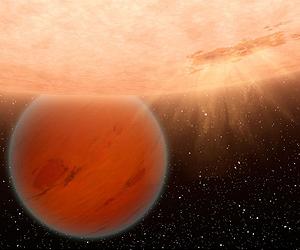|
 This Planet Smells Funny
This Planet Smells FunnyHuntsville AL (SPX) Sep 14, 2010 Giant planet GJ 436b in the constellation Leo is missing something. Would you believe swamp gas? To the surprise of astronomers who have been studying the Neptune-sized planet using NASA's Spitzer Space Telescope, GJ 436b has very little methane (CH4). "Methane should be abundant on a planet of this temperature and size, but we found 7000 times less methane than what the models predict," says Kevin Stevenson of the University of Central Florida (UCF). Stevenson was lead author of a paper reporting ... read more |
. |
|
|
Free Space, Earth, Energy And Military Newsletters - Delivered Daily |
| . | . |
| .. |
Scientists looking to spot alien oceans Seattle (UPI) Sep 9, 2010
Seattle (UPI) Sep 9, 2010 A U.S. space telescope set for launch in 2014 could reveal the presence of oceans on planets outside the solar system, scientists say. Detecting water on Earth-like planets would offer the tantalizing prospect they could sustain life, and scientists hope the reflection of light, or "glint", from mirror-like ocean surfaces could be picked up by the upcoming generation of space telescopes ... more NASA Opens Space Station For Biological Research From NIH Grants  Washington DC (SPX) Sep 13, 2010
Washington DC (SPX) Sep 13, 2010NASA is enabling biomedical research with National Institutes of Health (NIH) grants that take advantage of the unique microgravity environment aboard the International Space Station to explore fundamental questions about important health issues. The NIH Biomedical Research on the International Space Station (BioMed-ISS) awards are the next step in a new partnership to apply the national l ... more How Microbes Could Help Colonize Mars  Moffett Field CA (SPX) Sep 10, 2010
Moffett Field CA (SPX) Sep 10, 2010Tiny rock-eating microbes could mine precious extraterrestrial resources from Mars and pave the way for the first human colonists. Just don't expect them to transform the red planet's surface into a new Earth on a short deadline, researchers say. One of the most promising planetary colonizers comes in the form of cyanobacteria. The ancient bacteria helped create a habitable Earth with oxyg ... more |
.. |
 Deadly Tides Mean Early Exit For Hot Jupiters  China preps next lunar space mission  Instant online solar energy quotes Solar Energy Solutions from ABC Solar |
.. |
|
|
Free Space, Earth, Energy And Military Newsletters - Delivered Daily |
|
|
. |
 NASA Data Shed New Light About Water And Volcanoes On Mars
NASA Data Shed New Light About Water And Volcanoes On MarsPasadena CA (SPX) Sep 10, 2010 Data from NASA's Phoenix Mars Lander suggest liquid water has interacted with the Martian surface throughout the planet's history and into modern times. The research also provides new evidence that volcanic activity has persisted on the Red Planet into geologically recent times, several million years ago. Although the lander, which arrived on Mars on May 25, 2008, is no longer operating, NASA scientists continue to analyze data gathered from that mission. These recent findings are based on data ab ... read more |
| The contents herein, unless otherwise known to be public domain, are Copyright 1995-2010 - SpaceDaily. AFP and UPI Wire Stories are copyright Agence France-Presse and United Press International. ESA Portal Reports are copyright European Space Agency. All NASA sourced material is public domain. Additional copyrights may apply in whole or part to other bona fide parties. Advertising does not imply endorsement, agreement or approval of any opinions, statements or information provided by SpaceDaily on any web page published or hosted by SpaceDaily. Privacy statement |
| Previous Issues | Sep 13 | Sep 10 | Sep 09 | Sep 08 | Sep 07 |